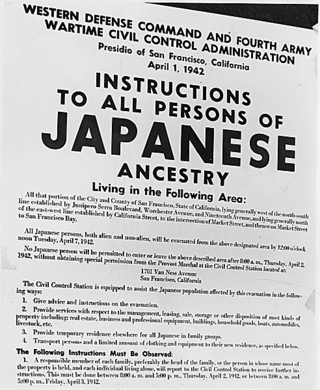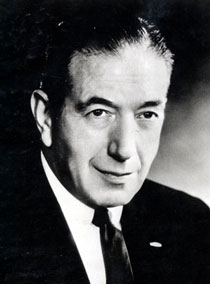Related Research Articles

Executive Order 9066 was a United States presidential executive order signed and issued during World War II by United States president Franklin D. Roosevelt on February 19, 1942. "This order authorized the forced removal of all persons deemed a threat to national security from the West Coast to "relocation centers" further inland—resulting in the incarceration of Japanese Americans." Two-thirds of the 125,000 people displaced were U.S. citizens.

During World War II, the United States forcibly relocated and incarcerated about 120,000 people of Japanese descent in ten concentration camps operated by the War Relocation Authority (WRA), mostly in the western interior of the country. Approximately two-thirds of the detainees were United States citizens. These actions were initiated by Executive Order 9066, issued by President Franklin D. Roosevelt on February 19, 1942, following Imperial Japan's attack on Pearl Harbor, Guam, the Philippines, and Wake Island in December 1941. Before the war, about 127,000 Japanese Americans lived in the continental United States, of which about 112,000 lived on the West Coast. About 80,000 were Nisei and Sansei. The rest were Issei immigrants born in Japan, who were ineligible for citizenship. In Hawaii, where more than 150,000 Japanese Americans comprised more than one-third of the territory's population, only 1,200 to 1,800 were incarcerated.
Korematsu v. United States, 323 U.S. 214 (1944), was a landmark decision by the Supreme Court of the United States that upheld the internment of Japanese Americans from the West Coast Military Area during World War II. The decision has been widely criticized, with some scholars describing it as "an odious and discredited artifact of popular bigotry", and as "a stain on American jurisprudence". The case is often cited as one of the worst Supreme Court decisions of all time. Chief Justice John Roberts repudiated the Korematsu decision in his majority opinion in the 2018 case of Trump v. Hawaii.
Magic was an Allied cryptanalysis project during World War II. It involved the United States Army's Signals Intelligence Service (SIS) and the United States Navy's Communication Special Unit.

The War Relocation Authority (WRA) was a United States government agency established to handle the internment of Japanese Americans during World War II. It also operated the Fort Ontario Emergency Refugee Shelter in Oswego, New York, which was the only refugee camp set up in the United States for refugees from Europe. The agency was created by Executive Order 9102 on March 18, 1942, by President Franklin D. Roosevelt, and was terminated June 26, 1946, by order of President Harry S. Truman.

The Civil Liberties Act of 1988 is a United States federal law that granted reparations to Japanese Americans who had been wrongly interned by the United States government during World War II and to "discourage the occurrence of similar injustices and violations of civil liberties in the future". The act was sponsored by California Democratic congressman and former internee Norman Mineta in the House and Hawaii Democrat Senator Spark Matsunaga in the Senate. The bill was supported by the majority of Democrats in Congress, while the majority of Republicans voted against it. The act was signed into law by President Ronald Reagan.

Fred Toyosaburo Korematsu was an American civil rights activist who resisted the internment of Japanese Americans during World War II. Shortly after the Imperial Japanese Navy launched its attack on Pearl Harbor, President Franklin D. Roosevelt issued Executive Order 9066, which authorized the removal of individuals of Japanese ancestry living on the West Coast from their homes and their mandatory imprisonment in incarceration camps, but Korematsu instead challenged the orders and became a fugitive.

Gordon Kiyoshi Hirabayashi was an American sociologist, best known for his principled resistance to the Japanese American internment during World War II, and the court case which bears his name, Hirabayashi v. United States.
Hirabayashi v. United States, 320 U.S. 81 (1943), was a case in which the United States Supreme Court held that the application of curfews against members of a minority group were constitutional when the nation was at war with the country from which that group's ancestors originated. The case arose out of the issuance of Executive Order 9066 following the attack on Pearl Harbor and the U.S. entry into World War II. President Franklin D. Roosevelt had authorized military commanders to secure areas from which "any or all persons may be excluded", and Japanese Americans living in the West Coast were subject to a curfew and other restrictions before being removed to internment camps. The plaintiff, Gordon Hirabayashi, was convicted of violating the curfew and had appealed to the Supreme Court. Yasui v. United States was a companion case decided the same day. Both convictions were overturned in coram nobis proceedings in the 1980s.
The Commission on Wartime Relocation and Internment of Civilians (CWRIC) was a group of nine people appointed by the U.S. Congress in 1980 to conduct an official governmental study into the internment of Japanese Americans during World War II.
The Japanese-American Claims Act is a law passed by the United States Congress and signed by President Harry S. Truman on July 2, 1948. The law authorized the settlement of property loss claims by people of Japanese descent who were removed from the Pacific Coast area during World War II. According to a Senate report on the Act, there were concerns about whether the United States government had the right to evacuate and place all people of Japanese ancestry in internment camps. As result of being placed in the Japanese internment camps there was great loss of property, belongings, business, "and the principles of justice and responsible government require that there should be compensation for such losses. "Congress over time appropriated $38 million to settle 23,000 claims for damages totaling $131 million. The final claim was adjudicated in 1965."
Executive Order 9102 is a United States presidential executive order creating the War Relocation Authority (WRA), the US civilian agency responsible for the forced relocation and internment of Japanese-Americans during World War II. The executive order was signed by President Franklin Roosevelt on March 18, 1942, and it officially expired on June 30, 1946. The Director reported directly to the president of the United States. Revealingly, like his Executive Order 9066, Roosevelt did not specifically mention or specify Japanese Americans in the entire text describing them with the euphemism "persons whose removal is necessary." By contrast, the numerous exclusion orders signed by General John L. DeWitt avoided any euphemisms and made clear that those to be removed were "persons of Japanese ancestry."
On February 19, 1942, shortly after Japan's surprise attack on Pearl Harbor in Hawaii, President Franklin D. Roosevelt signed Executive Order 9066 authorizing the forced removal of over 110,000 Japanese Americans from the West Coast and into internment camps for the duration of the war. The personal rights, liberties, and freedoms of Japanese Americans were suspended by the United States government. In the "relocation centers", internees were housed in tar-papered army-style barracks. Some individuals who protested their treatment were sent to a special camp at Tule Lake, California.
The following article focuses on the movement to obtain redress for the internment of Japanese Americans during World War II, and significant court cases that have shaped civil and human rights for Japanese Americans and other minorities. These cases have been the cause and/or catalyst to many changes in United States law. But mainly, they have resulted in adjusting the perception of Asian immigrants in the eyes of the American government.

Karl Robin Bendetsen was an American politician and military officer who served in the Washington Army National Guard during World War II and later as the United States Under Secretary of the Army. Bendetsen is remembered primarily for his role as an architect of the internment of Japanese Americans during World War II, a role he tried to downplay in later years.
Mitsuye "Maureen" Endo Tsutsumi was an American woman of Japanese descent who was placed in an internment camp during World War II. Endo filed a writ of habeas corpus that ultimately led to a United States Supreme Court ruling that the U.S. government could not continue to detain a citizen who was "concededly loyal" to the United States.
Aiko Herzig-Yoshinaga was a Japanese American political activist who played a major role in the Japanese American redress movement. She was the lead researcher of the Commission on Wartime Relocation and Internment of Civilians (CWRIC), a bipartisan federal committee appointed by Congress in 1980 to review the causes and effects of the Japanese American incarceration during World War II. As a young woman, Herzig-Yoshinaga was confined in the Manzanar Concentration Camp in California, the Jerome War Relocation Center in Arkansas, and the Rohwer War Relocation Center, which is also in Arkansas. She later uncovered government documents that debunked the wartime administration's claims of "military necessity" and helped compile the CWRIC's final report, Personal Justice Denied, which led to the issuance of a formal apology and reparations for former camp inmates. She also contributed pivotal evidence and testimony to the Hirabayashi, Korematsu and Yasui coram nobis cases.
Virginia Dare Aderholdt was an Arlington Hall cryptanalyst and Japanese translator. She decrypted the intercepted Japanese surrender message at the close of World War II on August 14, 1945.

Cherry Kinoshita was a Japanese American activist and leader in the Japanese American Citizens League (JACL). She helped found the Seattle Evacuation Redress Committee and fought for financial compensation for Japanese Americans who had been incarcerated during World War II.
Lane Ryo Hirabayashi, was an American historian who focused on the World War II internment of Japanese Americans. He recommended to use the term incarceration instead of internment. "He was at the forefront of scholars calling for the use of more precise terminology regarding the forced uprooting and incarceration of Japanese Americans during World War II, and for avoiding government euphemisms such as “evacuation” and “relocation.” He also argued that “comparative research relating this history to the internment of Middle Eastern and Muslim detainees, and the incarceration of militant activists of color and prisoners of conscience, is imperative.” Hirabayashi was an early member of The National Coalition for Redress/Reparations (NCRR), an organization that sought to right historical wrongs by returning money and land taken through incarceration during the war.
References
- 1 2 Milligan, Richard L. (September 1, 2002). "MAGIC: The Untold Story of U.S. Intelligence and the Evacuation of Japanese Residents from the West Coast during World War II". Military Review. Vol. 82, no. 5. p. 107.
- 1 2 Mohr, Charles (May 22, 1983). "1941 Cables Boasted of Japanese-American Spying". The New York Times . Retrieved October 4, 2018.
- ↑ "Defense Rests on 40s Internment". The New York Times . June 28, 1985. Retrieved October 4, 2018.
- ↑ Curry, Bill (February 11, 1986). "Japanese Internment Held Improper by Federal Judge". Los Angeles Times . Retrieved October 4, 2018.
- ↑ "Obituaries". The Capital . May 4, 2006. p. A13.
- 1 2 Kirsch, Jonathan (March 7, 2001). "Posthumous book is based on intercepted wartime communications with Japan". Los Angeles Times . Retrieved October 4, 2018.
- 1 2 House, Dawn (August 25, 2002). "Japanese-Americans' Role In World War II Debated". The Salt Lake Tribune . p. A1.
- 1 2 "Magic: The Untold Story of U.S. Intelligence and the Evacuation of Japanese Residents from the West Coast during World War II". Publishers Weekly . Vol. 248, no. 1. January 1, 2001. p. 80. Retrieved October 4, 2018.